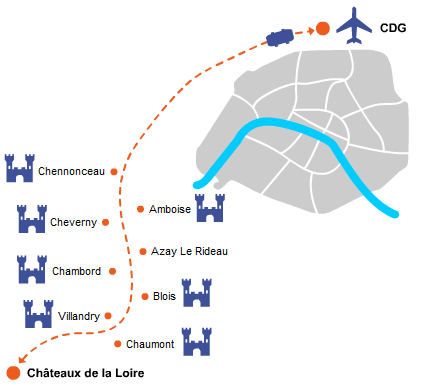Choose your route
Transfer CDG Airport - Castle on Loire valley

CDG Airport - Castle in the Loire Valley
Private car and van transfer to/from CDG Airport to Castle on Loire Valley
| Passengers | 1 - 2 | 4 - 5 | 6 - 7 | Action |
|---|---|---|---|---|
| CDG Airport - Castle on Loire Valley | €590 | €680 | €730 | Book now |
| CDG Airport - Tours | €540 | €570 | €690 | Book now |
| Angers - CDG Airport | €640 | €820 | €860 | Book now |
Start your Loire Valley journey with a smooth private transfer from CDG Airport directly to your chosen castle. Our professional service ensures a relaxed experience, offering elegant vehicles and punctual drivers. On the way, admire the picturesque landscapes of the Loire region, famous for its breathtaking beauty and rich history. While exploring the area, you can visit the Château de Chenonceau, with its iconic arches spanning the river, or the grand Château de Chambord. Our priority is to make your travel easy and enjoyable, with full support available. Find helpful details through our faq about airport transfers and plan stress-free. Enjoy a comfortable journey at your own pace, ensuring a stylish arrival at one of France’s most stunning destinations.
On the return or for another trip, trust our routes like CDG Airport to Tours or Angers to CDG Airport. Tours offers cultural wonders such as the Saint-Gatien Cathedral and the lovely Place Plumereau, ideal for leisurely walks. Meanwhile, Angers presents the impressive Château d’Angers and the tranquil Jardin du Mail. All trips are made efficient and comfortable by our skilled drivers, ensuring your satisfaction every step of the way. Book today, and for full pricing information, explore our rates for airport service page to plan your perfect journey with us.
Book a private minivan transport between Charles de Gaulle airport and the castles of the Loire Valley
- Castles of the Loire Valley: A Journey through French History
- Stay at Château de la Bourdaisière
- Discover the Château d'Ussé
- Distance between the of the Loire valley and Paris airports


















